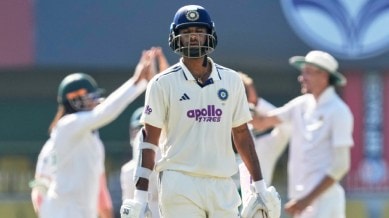Stay updated with the latest sports news across Cricket, Football, Chess, and more. Catch all the action with real-time live cricket score updates and in-depth coverage of ongoing matches.
Why India’s batters don’t have footwork or gameplan to master home conditions
Gautam Gambhir can hark back to the England series, but without taking anything away from the young team the series was played on flat wickets; on turning tracks at home, India's batsmen don't have patience or tactics to put opposition bowlers under pressure.

When the Indian team bus veered into the ACA Stadium on Wednesday morning, head coach Gautam Gambhir was perched in the front seat with the typical poker-face. The digits plastered over his jaw still suggested a worrying undercurrent.
The bastions of the famous “Final Frontier” were collapsing. After four successive home Test defeats to SENA teams and as many days of protracted embarrassment in Guwahati, Gambhir and an ecosystem curated entirely to his design, was trying to salvage a quantum of the great Indian red-ball game from the ruins for posterity.
A drier day, a shriveling pitch and the inexplicable surrender of the top order under 120 minutes resigned Gambhir’s India to their heaviest defeat by runs (408) in history, an unforgettable blot on the great Indian home canvas spanning 298 matches. A day after the BCCI had unveiled “a first-of-its-kind” official colour partner, their glorious 92-year-old Test team had conceded a second whitewash at home in a year.
The alarm bells from the 3-0 hammering to New Zealand in late 2024 unofficially began the transition under Gambhir’s watch. It fast-tracked the exits of R Ashwin, Virat Kohli, Rohit Sharma – vital gatekeepers of India’s home dominance for over a decade since the last transition was processed from early 2013.
In the months that have followed, Gambhir and his chosen ones have glinted nothing but mediocrity in the early transitional phase that warrants intense scrutiny. The England tour and a dramatic Oval finish in August 2025 presented a false dawn. Batting on the flattest wickets designed for the Bazball fever, the pitches accounted for the second-most runs (7,187) ever in a bi-lateral Test series then. The transition was magically complete, they said, after levelling the tie 2-2 in London.
“I am the same guy who got results in England as well. With a young team, I am sure you guys will forget very soon because a lot of people keep talking about the New Zealand (series),” Gambhir reiterated in the post-match press conference on Wednesday.
But the plagued defences and strokeplay convulsions on a pitch a Guwahati thoroughbred termed a typical “slow paata”, enlarged the malaise that has wrecked the conditional adaptabilities of Gambhir’s team and coaching set-up.
Muddled thinking
As observed since the Day 3 spill-over, the muddled Indian bats are unable to comprehend between tactics and indispensable foot-work for two contrasting situations, two successive deliveries and innings of starkly different purposes. During their first-innings response to South Africa on what was still a benign strip, the batting was marred by the reckless shot-making against the evolving seam giant, Marco Jansen. They were shot down in a little over 80 overs for 201 runs, spending under half the time the Proteas expended on their 489-run monument.
Pegged by the overnight shockers from openers Yashasvi Jaiswal and KL Rahul, the Indians went outright defensive, the scoreboard projecting an insurmountable 522 runs before them on a Day 5 pitch. The idea wasn’t bereft of logic, it was one of the fewer options that Ravindra Jadeja felt would give his side a “win-win” feeling even if they were to lose the series.
But then on a strip that finally began to deflect deliveries from the browner patches, there were certain forms of defense that benefited. It is exactly why Sai Sudharsan’s driven, 139-ball blockathon for 14 runs did not serve anything meaningful, just as captain Rishabh Pant’s aggressive wonts wouldn’t have single-handedly cut the deficits.
None of India’s top-order bats are staple employers of the sweep shot, the stroke that the Saffers contextualised with a defensive coating in their second innings. Jadeja could unfurl firm sweeps but even he wasn’t one for the reverse stroke that the likes of Tristan Stubbs and Tony de Zorzi executed to deflate the Indian spinners on a deteriorating Day 4 surface.
Three of India’s dismissals in the morning were of deliveries that didn’t turn from the riveting Simon Harmer. Nightwatcher Kuldeep Yadav was unlucky, perhaps, his resistance ended by a sharp side-spinner that went scooting low with the angle to stumps. But Dhruv Jurel and Sudharsan were left with no excuses for their defensive wafters, accounting for Harmer’s hallowing lines that propelled everything, everywhere, all at once.
In the end, the reverse-sweep plopped from a mindless afterthought. No. 9 Nitish Reddy’s stab was picked up by Harmer’s flighter from outside off-stump and parried to the keeper, powering the resurgent 36-year-old to his career-best figures (6/37).
India’s 266 minutes of distress ended with a moment that encapsulated the widening gulf between Gambhir’s men and the true precipice of Test dominance. Ambling diagonally backwards from mid-on, it was Jansen who dropped the final wrecking ball, leaving Mohammed Siraj in tatters. The one-handed overhead pluck at the boundary edge embellished the Proteas world crown, now studded with a series win in every WTC-playing Asian country this century.
As Temba Bavuma jogged up to the nine men who mobbed their new pace heartthrob at long off, the Indians cut a sorry figure, bereft of light or spirits to lift themselves up from the deepest trenches.